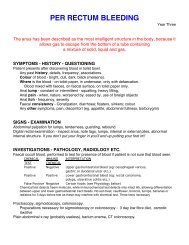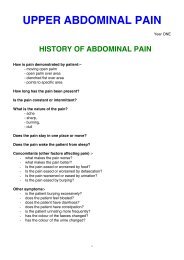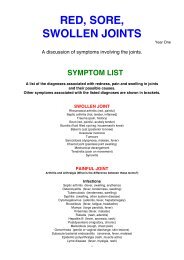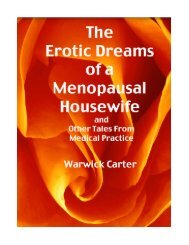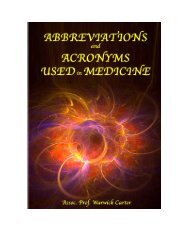Menopause A to Z.pdf - Medwords.com.au
Menopause A to Z.pdf - Medwords.com.au
Menopause A to Z.pdf - Medwords.com.au
Create successful ePaper yourself
Turn your PDF publications into a flip-book with our unique Google optimized e-Paper software.
MENOPAUSE A <strong>to</strong> Z<br />
cancer of the uterus, and these women only need <strong>to</strong> take the oestrogen, and proges<strong>to</strong>gens are unnecessary.<br />
These hormones maintain the body in a near normal balance, while underneath the artificial hormones, the natural<br />
menop<strong>au</strong>se is occurring, so that when the tablets are s<strong>to</strong>pped after a year or two, the menop<strong>au</strong>sal symp<strong>to</strong>ms will have<br />
gone.<br />
Hormone replacement therapy (HRT) can be given as tablets, skin patches, skin cream, vaginal cream, vaginal<br />
pessaries, implants, nasal spray or injection.<br />
Every woman must assess her own needs in consultation with her doc<strong>to</strong>r regarding her lifestyle expectations and<br />
the risks of using HRT. Many women are now continuing hormone replacement therapy (HRT) for many years after the<br />
menop<strong>au</strong>se <strong>to</strong> prevent osteoporosis (and the resultant fractured bones), and <strong>to</strong> slow ageing. Generally speaking, HRT<br />
has been a major advance in the health of women, who now outlive men by an average of more than seven years.<br />
Concerns about the safety of hormone replacement therapy (HRT) relate <strong>to</strong> long-term (greater than five years) use<br />
of <strong>com</strong>bined (oestrogen and proges<strong>to</strong>gen) HRT. Short-term use for up <strong>to</strong> five years is still apparently safe and is used<br />
<strong>to</strong> control the symp<strong>to</strong>ms of menop<strong>au</strong>se (eg. hot flushes, dry vagina, aching).<br />
Long-term use needs <strong>to</strong> be weighed for each individual woman according <strong>to</strong> her risk fac<strong>to</strong>rs for heart disease,<br />
osteoporosis, breast cancer, stroke and blood clot.<br />
The points for and against <strong>com</strong>bined hormone replacement therapy are outlined as simply as possible in the<br />
following list.<br />
EFFECTS OF COMBINED OESTROGEN AND PROGESTOGEN HORMONE REPLACEMENT THERAPY<br />
BENEFITS:<br />
- Improved sense of well-being<br />
- Increases libido (sexual desire).<br />
- Lubricates the vagina and enhances sexual pleasure.<br />
- Breast shape retained for longer without drooping<br />
- Reduced risk of bowel cancer (risk decreases from 1.6 women in every 1000 developing bowel<br />
cancer in any one year <strong>to</strong> 1.0)<br />
- Significantly reduced risk of osteoporosis (risk decreases from 1.5 women in every 1000 having a<br />
hip fracture from osteoporosis in any one year <strong>to</strong> 0.9)<br />
- Slightly reduced incidence of heart disease.<br />
- Delays onset of dementia.<br />
- Improves bladder capacity and control<br />
- Slows the development of wrinkles and keeps the skin moist and more elastic.<br />
- Improves mood and reduces irritability<br />
- Relieves the hot flushes, depression, bloating, insomnia and other symp<strong>to</strong>ms of menop<strong>au</strong>se.<br />
DISADVANTAGES:<br />
- Increases growth of existing breast cancer<br />
- Increased risk of blood clots in veins (leg blood clots) (risk rises from 1.1 women in every 1000<br />
developing a blood clot in any one year <strong>to</strong> 2.9)<br />
- Breast tenderness and break through bleeding in early stages of use.<br />
- N<strong>au</strong>sea and belly cramps may occur and migraines may be aggravated.<br />
NEUTRAL EFFECTS<br />
- No effect on weight gain or loss.<br />
- No reduction in migraines or headaches.<br />
If oestrogen is used alone without a proges<strong>to</strong>gen, there is also an increased risk of endometrial and ovarian cancer.<br />
The concurrent use of a proges<strong>to</strong>gen negates these risks.<br />
Except under special circumstances, women who have had cancer of the breast, uterus or cervix; hormonal mastitis<br />
(breast pain), endometriosis, blood clots (thromboses) or strokes, should not use HRT.<br />
Overall, the risk of using HRT is very small, and the latest research shows that women who use HRT <strong>to</strong> control hot<br />
flushes, mood swings, pelvic fullness and breast dis<strong>com</strong>fort are far less likely <strong>to</strong> develop serious side effects than<br />
women who use HRT with no significant symp<strong>to</strong>ms. The short-term benefits of HRT on menop<strong>au</strong>sal symp<strong>to</strong>ms may in<br />
fact give a better long-term quality of life.<br />
See also OESTRADIOL; OESTROGEN; SEX HORMONES; STILBOESTROL; UTERUS<br />
HYDROXYPROLINE/CREATININE RATIO<br />
The ratio between the chemicals hydroxyproline and creatinine in blood can be measured. The normal level is<br />
less than 0.02. High levels may indicate Paget’s disease of bone, hyperparathyroidism (over active parathyroid gland),<br />
osteomalacia (bone disease), hyperthyroidism (over active thyroid gland), osteoporosis after the menop<strong>au</strong>se, kidney<br />
failure or a severe fracture. The ratio is a measure of the bone breakdown rate and calcium loss. Calcium<br />
24




